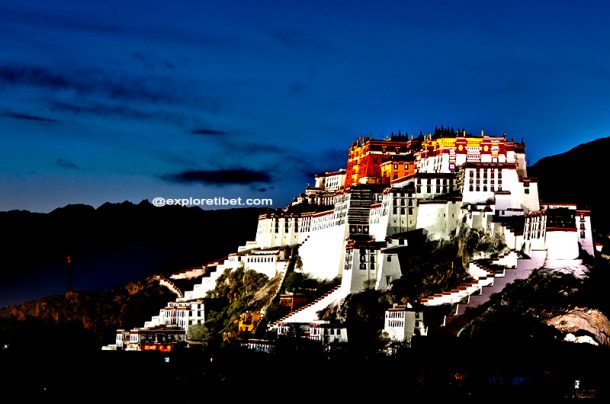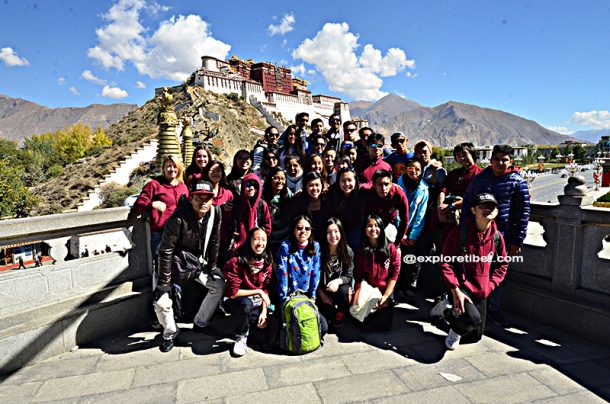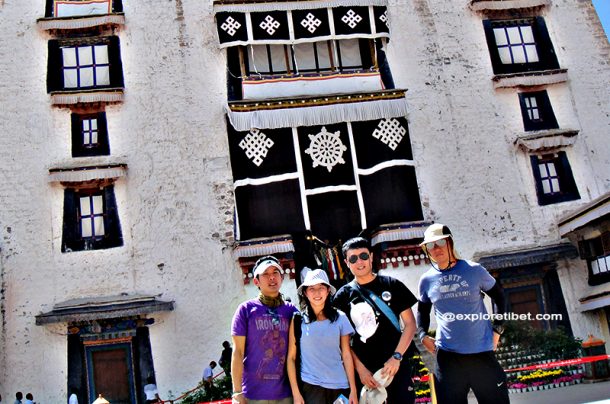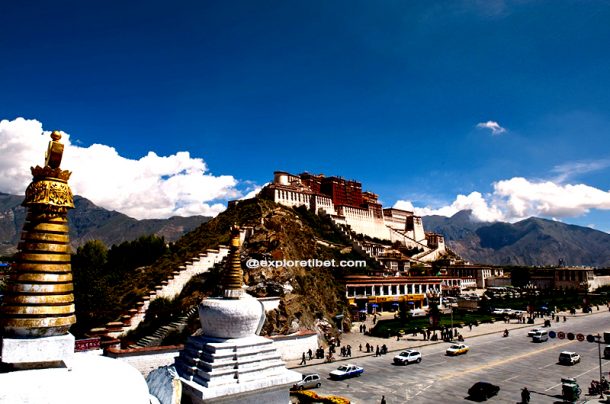What To Know Before Visiting The Potala Palace in Tibet

Night Scene of the Potala Palace
Table of Contents
What to know before visiting the Potala Palace
Before visiting the Potala Palace, it is good to know little about it, once the seat of the Tibetan government and the winter palace of the Dalai Lama is one of Lhasa’s cardinal landmarks, and the sight of its towering walls reminds one of an ancient fortress. Even by modern standards, the palace is a wonder of architecture, rising thirteen stories high from the top of Moburi Hill and containing more than one thousand rooms. Tourists and pilgrims alike shuffle awe-struck through its gates to gaze in wonder at the dozens of chapels, the magnificent golden stupas, and the holy prayer halls.
A short history of Potala Palace
The first historical records of the site’s use date back to the 7th century, when the 33rd King of Tibet, Songtsen Gampo, first constructed a palace as a gift for his bride-to-be. Destroyed during wars in the ninth century, the original structure was built over during the reign of the fifth Dalai Lama in 1645. After more than 50 years of construction, it became the Potala Palace you see today. Laid out in two parts, the outer White Palace is used as the living quarters of the Dalai Lama and the various monks in residence, while the central Red Palace is used for mainly religious functions.
Within the Red, Palace lie the mausoleums of the previous Dalai Lamas, and the mausoleum of the fifth Dalai Lama, the palace’s patron, lies in the west of the palace. This holy monument is five stories high, is overlaid with gold, pearls, diamonds, and other precious gems, and is held in high honor by the Tibetan people.

Group Photo at the Potala Palace
Tickets and getting into Potala Palace
From April to October – the peak season of Tibetan tourism – there are a limited number of visitors allowed into the palace per day. This is done to protect the palace and the holy relics inside from damage caused by excessive visitors. For travel agencies, it is limited to a maximum group of seven people a day.
Since tickets for the Potala Palace are limited, the reservation vouchers need to be booked at least one day in advance and sometimes more during the peak season. The time of entry is printed on the voucher, along with the number of visitors and the purchaser’s ID document number. On the date and time of entry, your reservation vouchers and ID documents will be checked at the main gate, and then you can proceed to the ticket office in front of the White Palace to get the entrance tickets.
It is advisable to be there at least an hour before your entry time. Unfortunately, the entry time is randomly generated, and it is impossible to request entry at a certain time. Moreover, the time on the ticket is when you will be allowed to enter, and if you are late or miss the time, you will not be allowed to enter. If you do miss your entry time, make sure you have the reservation vouchers canceled or extended at the voucher office to allow you to get another entry time on another day.
One of the main problems that occur when visitors miss their allotted entry time and do not get the reservation canceled or extended is not getting another ticket for a week. Valid ID cards or passports are required to purchase the reservation vouchers for the tickets. The details are printed on the voucher and ticket, and it is not permitted to make another reservation for tickets using the same ID or passport within the same week.
As you enter the site, you will need to go through security checks. It is useful to remember that cigarettes, lighters, knives (and any object that could be used to pry gems from the relics), and water bottles are not permitted inside. Water can be purchased inside the Palace if you get thirsty. There is normally only an hour in the peak season for each person to tour the palace, although this increases to two hours during the low season since there are normally fewer visitors.
The tickets for the entrance to the palace are higher in the high season than in the low season. In the low season, from November to March, tickets are normally only 100CNY per person, except on special holy days and festivals. However, during the high season for Tibetan tourism, from April to October, the ticket price doubles per person to 200CNY.

Group Photo at Deyang Shar in Potala Palace
Tips on visiting Potala Palace
One thing to remember when traveling to Tibet is that the lifestyle and culture there are very different from anywhere else you might visit. Tibet is a region of devout Buddhists, and respect for the culture, traditions, and taboos should be observed. This is especially important when visiting temples, monasteries, and palaces such as Potala Palace.
For your visit to go without a hitch, there are a few things to remember about Tibetan taboos before you go. Potala is a sacred site, so modest clothing is expected. Please do not wear shorts and skirts when visiting the palace, but bring a coat, as it is quite cold inside. Photography and video recording are not permitted inside the palace due to the nature of the sacred site and the ancient relics it contains. Hats and sunglasses should be removed, and it is considered bad luck to step on the threshold of a doorsill when entering.
The long climb to the top
Unfortunately, there are no lifts, elevators, or escalators up to the Potala Palace; instead, you have the pleasure of climbing the hundreds of steps to the top. Climbing to the top can be exhausting, even without the increased altitude. At an elevation of 3,750 meters (12,300 feet), climbing the 432 steps to the Potala Palace is even harder work. But the tour of the inside of the palace is more than worth it, so take it slowly and enjoy the spectacular views looking down over Lhasa and the surrounding countryside as you climb.

View of the Potala Palace from Chakpo Ri Hill
Recent Posts
The Ultimate Guide to Tibet Tours, Travel, and Trekking Adventures
How to Explore Tibetan Culture
Exploring Lhasa:The Heart of Tibet
All Categories
- About Tibet
- book a Tibet tour
- Buddhism Practice
- Budget Tour
- China-Tibet Train
- Customized Tibet tour
- Historical Sites
- Hot Springs in Tibet
- News
- Photography in Tibet
- Tibet attraction
- Tibet Group Visa
- Tibet Motorcycle Tour
- Tibet Small Group Tours
- Tibet Tours and Tibetan Tour Guide
- Tibet Train
- Tibet Travel FAQs
- Tibet Travel Information
- Tibet Travel News
- Tibet Travel Permit Update
- Tibet Travel Prices Rises
- Tibet Trek
- Tibet Trekking Tour
- Tibet weather and climate
- Tibet Wildlife animals
- Tibet Winter Tour
- Tibetan Buddhism
- Tibetan Cultural Features
- Tibetan Culture and Poeple
- Tibetan Festivals
- What to see in Tibet



